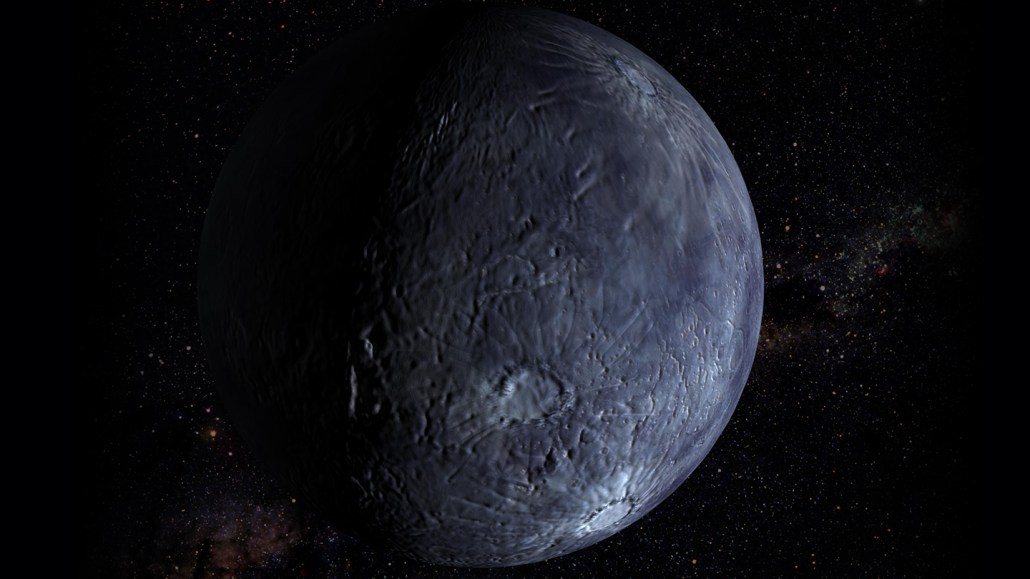The dwarf planet Quaoar hosts an impossible ring
The ring is much wider than a typical mathematical limit should allow

The dwarf planet Quaoar (illustrated) is only the third small object in the solar system with a known ring.
Illustration Credit: NASA, G. Bacon/STScI; Science Credit: NASA, M. Brown/Caltech
Share this:
- Share via email (Opens in new window) Email
- Click to share on Facebook (Opens in new window) Facebook
- Click to share on X (Opens in new window) X
- Click to share on Pinterest (Opens in new window) Pinterest
- Click to share on Reddit (Opens in new window) Reddit
- Share to Google Classroom (Opens in new window) Google Classroom
- Click to print (Opens in new window) Print
The solar system is full of ringed bodies. There’s Saturn, of course. Plus Jupiter, Uranus and Neptune. The asteroid Chariklo and the dwarf planet Haumea sport rings, too. All those rings lie within or near a mathematically determined distance of their parent bodies. But now, the dwarf planet Quaoar has been found with a ring that breaks this rule. Quaoar’s ring circles the dwarf planet much farther out than should be possible.
“For Quaoar, for the ring to be outside this limit is very, very strange,” says Bruno Morgado. He’s an astronomer at the Federal University of Rio de Janeiro in Brazil. He and his colleagues shared the discovery of Quaoar’s strange ring February 8 in Nature. The finding may force scientists to rethink the rules governing planetary rings.
Getting a glimpse of Quaoar
Quaoar (KWAH-war) is a dwarf planet. That is, it’s a round world orbiting the sun that is not quite big enough to be a planet. An icy body about half the size of Pluto, Quaoar is located in the Kuiper Belt at the solar system’s edge. That far away from Earth, it’s hard to get a clear picture of this frigid world.
Morgado and his colleagues watched Quaoar block the light from a distant star. The timing of the star winking in and out of view can reveal details about Quaoar, like its size and whether it has an atmosphere.
The researchers looked at data from Quaoar passing in front of stars from 2018 to 2020. Those data came from telescopes all over the world, such as in Namibia, Australia and Grenada. Some observations also came from telescopes in space.
There was no sign that Quaoar had an atmosphere. But surprisingly, it did have a ring. Even more surprisingly, Morgado says, “the ring is not where we expect.”
Far-out ring
In this illustration, the dwarf planet Haumea and asteroid Chariklo both have rings (white) that are close to their Roche limits (yellow). Quaoar, on the other hand, has a ring that is clearly well beyond its Roche limit. The Roche limit is an imaginary line beyond which rings are thought to be unstable.
Rings around three small objects in the solar system
Rule-breaking ring
All other known rings around objects in the solar system lie within or near the “Roche limit.” That’s an invisible line where the gravitational force of the main body fades away. Inside the limit, the gravity of the main body can rip a moon to shreds, turning it into a ring. Outside the Roche limit, the gravity between smaller particles is stronger than that from the main body. So, the particles that make up rings will bunch together into one or several moons.
“We always think of [the Roche limit] as straightforward,” Morgado says. “One side is a moon forming. The other side is a ring.” But Quaoar’s ring lies far out, on what should be the moon side of the Roche limit.
There are a few possible explanations for Quaoar’s weird ring, Morgado says. Maybe his team caught a glimpse of the ring just before it turned into a moon. But that lucky timing seems unlikely, he notes.
Maybe the gravity of Quaoar’s known moon, Weywot, or some other unseen moon, holds the ring stable somehow. Or maybe the ring’s particles are colliding in a way that keeps them from sticking together and clumping into moons.
The particles would have to be really bouncy for that to work, says David Jewitt. “Like a ring of those bouncy balls from toy stores.” Jewitt is a planetary scientist at the University of California Los Angeles. He was not involved in the new work. But he did help discover the first objects in the Kuiper Belt in the 1990s.
The new observation of Quaoar’s ring is solid, says Jewitt. But there’s no way to know yet which explanation is correct, if any. To find out, scientists need to build models of each scenario, such as the bouncy particle idea. Then, researchers can compare those models to observations of Quaoar’s real-life ring. That will help them decide which scenario best explains what they see.
Starting with observations and coming up with theories to explain them is often how Kuiper Belt research goes. “Everything in the Kuiper Belt, basically, has been discovered, not predicted,” Jewitt says. “It’s the opposite of the classical model of science where people predict things and then confirm or reject them. People discover stuff by surprise [in the Kuiper Belt], and everyone scrambles to explain it.”
More observations of Quaoar could help reveal what’s going on. So could more discoveries of odd rings elsewhere in the solar system. Says Morgado, “I have no doubt that in the near future a lot of people will start working with Quaoar to try to get this answer.”







